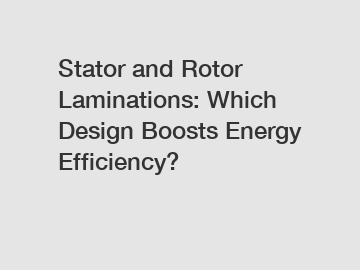Feb. 06, 2024
Hardware
CHME Product Page
Stator and Rotor Laminations: Which Design Boosts Energy Efficiency?
In the world of electric motors, stator and rotor laminations play a critical role in achieving high energy efficiency. These laminations, typically made from materials like electrical steel or laminated silicon steel, are used to minimize energy losses caused by magnetic hysteresis and eddy currents. However, not all lamination designs are created equal when it comes to optimizing energy efficiency. Let's explore the different designs of stator and rotor laminations and determine which one can provide a significant boost in energy efficiency.

Stacked Laminations vs. Wound Cores: A Comparison of Stator Designs.
In the design of the stator, the most common choice is between stacked laminations and wound cores. Stacked laminations consist of individual insulated steel plates stacked together, while wound cores have a continuous strip of electrical steel wound in a spiral configuration.
Stacked laminations offer several advantages over wound cores when it comes to energy efficiency. Firstly, the insulation between the laminations effectively reduces the losses caused by eddy currents. These laminations also provide better magnetic coupling between the coils, leading to improved efficiency. Moreover, stacked laminations enable easier manufacturing and assembly processes, making them a popular choice in most electric motor applications.
Rotor Laminations: Die-Cast vs. Wound.
When it comes to rotor designs, two primary options are die-cast rotors and wound rotors. Die-cast rotors are made by pouring molten aluminum alloy into a mold, while wound rotors involve winding wire coils around a laminated iron core.
While die-cast rotors are commonly used due to their cost-effectiveness and ease of production, wound rotors offer higher energy efficiency. The laminated iron core in wound rotors reduces the eddy current losses, leading to better performance. Additionally, wound rotors allow for more compact design and better cooling, further enhancing their energy efficiency.
Optimizing Energy Efficiency through Core Stacking Techniques.
Apart from the choice of lamination design, core stacking techniques can also influence the overall energy efficiency of electric motors. One such technique is segmenting the laminations into smaller pieces and assembling them together using non-conductive adhesives. This approach reduces the eddy current losses and improves the overall efficiency of the motor. Another technique involves using stepped laminations, where the thickness of the laminations is reduced towards the outer edges of the core. This design minimizes magnetic hysteresis losses, resulting in higher energy efficiency.
Conclusion: The Path to Ultimate Energy Efficiency.
In conclusion, selecting the right design for stator and rotor laminations is crucial in achieving high energy efficiency in electric motors. Stacked laminations and wound cores offer better performance in stator designs, while wound rotors outshine die-cast rotors in increasing efficiency. Furthermore, core stacking techniques such as segmentation and stepped laminations can provide additional improvements in energy efficiency.
To learn more about the optimal design of stator and rotor laminations and how they can enhance energy efficiency in electric motors, please contact us. Our team of experts will be more than happy to assist you and provide further guidance in this area.
If you want to learn more, please visit our website.
The company is the world’s best stator and rotor manufacturer supplier. We are your one-stop shop for all needs. Our staff are highly-specialized and will help you find the product you need.
Previous: What drill bit is used for granite?
If you are interested in sending in a Guest Blogger Submission,welcome to write for us!
All Comments ( 0 )